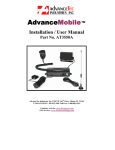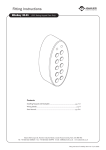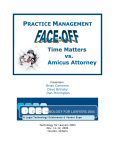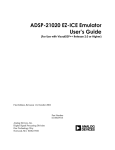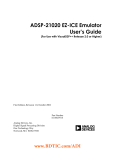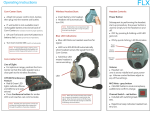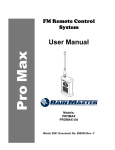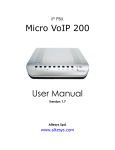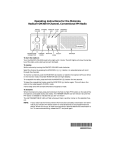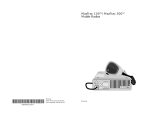Download Radius GM300 Mobile Radio Operating Instructions
Transcript
GM300_Owners.doc Page 15 Thursday, May 30, 1996 9:39 AM GM300 Mobile Radios Operating Instructions Control Unit Select Signalling mon mon scan mon tx Pri User Scan scan sel mon scan tx Pri User Scan scan sel Display of Incoming Identification Numbers Whenever an operator in the system presses the PTT button, the unit identification number (ID) will be shown on the display for 10 seconds or less if another incoming ID is received. Activating the Call List for Sending Selective Messages Pressing the SELECT button [ ] will activate the Call List. The most recently used ID number and the call letters will alternately be displayed. The following call letters may be displayed when using a call list. SC – Voice Selective Call: Call a particular unit or group with a voice message. CA – Call Alert: Select a unit or group and leave a “call-back” indicator. CH – Radio Check: Check to see if a unit is turned on and within range. These letters will alternate on the display with the unit or group ID number. Choosing Call List Letters and ID Numbers Each press of the SELECT button [ ] causes the display to move down the list of call letters which have been programmed in the unit. Pressing the UP/DOWN buttons [ ] will change the ID numbers. All Call List ID numbers will be displayed with each set of call letters. However, some ID’s may not be compatible with certain call types. For example, a group ID cannot be Radio Checked. In such cases, pressing the PTT button will result in a low pitched tone to indicate that the function is not available. Sending a Signalling Message Once the desired call letters and ID numbers have been selected, pressing the PTT button will send the message. The display will revert to the preprogrammed transmit channel to send the signalling message and the channel will be briefly displayed while the message is being transmitted. May, 1996 6880902Z09-B 15 GM300_Owners.doc Page 16 Thursday, May 30, 1996 9:39 AM Operating Instructions GM300 Mobile Radios Receiving an Acknowledgment Depending on the signalling format used, the sending radio may look for an acknowledgment from the receiving unit on Call Alert and Radio Check calls. The sending radio will show an “A” and 4 alert tones will sound if the target unit received and acknowledged the call. If no acknowledge is received, the sending unit will make another 4 tries. If unsuccessful, a “-A” will be displayed and a low pitched tone will sound to indicate no acknowledge. Exiting the Call List The SELECT button [ ] is used to exit the signalling call list. Repeated pressing of the SELECT button [ ] takes you through the sequence of call letters to the channel display for normal operations. Receiving an Emergency Alarm When an emergency alarm is received by the control unit, an alert tone will sound. The display will alternate “EE” and the ID number of the radio sending the emergency. Five different emergency ID’s can be queued. However, the first ID to be received will be displayed until it is cleared. Then the next ID in the queue will be displayed until each has been displayed and cleared. Press the PTT button to respond to the emergency alert. If the sending radio has been programmed for silent emergency it will remain muted and no messages will be heard. However, other radios using the channel will receive transmissions. Clearing an Emergency Alarm To prevent accidentally losing an incoming emergency, the clearing of an emergency alarm has been designed as a two step process. First, the alert tone must be cleared by pressing any button on the radio. Second, press an external switch, such as the footswitch or pushbutton. The Emergency display will then clear. 16 6880902Z09-B May, 1996 GM300_Owners.doc Page 17 Thursday, May 30, 1996 9:39 AM GM300 Mobile Radios Operating Instructions DTMF ANI Phone Access Operating Instructions mon mon scan mon tx Pri User Scan scan sel mon scan tx Pri User Scan scan sel Radio is in normal operating mode. Check the Busy LED to be sure the channel is free before pressing the SELECT button [ ]. See Note 1. Press the SELECT button [ ]. The DTMF access code will automatically be transmitted and “PH” will appear on the display. See Note 2. A call can be manually dialed using the standard Touch Code microphone. The radio will be in carrier squelch mode. Press SELECT button [ ] after the call is completed to send the deaccess code. The radio returns to normal operating mode and its prior monitor or coded squelch state. See Note 3. NOTE 1. If you press the SELECT button [ ] when the channel is busy you will hear a low pitched tone. The radio will revert to monitor mode so you can listen for a free channel. Press the Select button again to send the Access code. NOTE 2. If the patch missed the Access code when it was sent, the user would have to press the SELECT button [ ] twice to reaccess the patch: once to deaccess and again to access. The same case is true for Deaccess. NOTE 3. If the radio reverted to monitor mode because of a busy channel for Access, it will return to monitor after Deaccess. Otherwise the radio will return to coded squelch. May, 1996 6880902Z09-B 17 GM300_Owners.doc Page 18 Thursday, May 30, 1996 9:39 AM Operating Instructions GM300 Mobile Radios Phone Memory List mon mon scan mon tx Pri User Scan scan sel mon scan tx Pri User Scan scan sel Up to 16 telephone numbers can be programmed by the dealer. One or two digit identifiers will then be used to represent these phone numbers. Press the SELECT button [ ] to enter Phone mode. Select the Phone Memory List by using the UP/DOWN buttons [ ]. The first press of the UP/DOWN button [ ] will recall the last phone number dialed. (This is not saved if the radio has been turned off.) Subsequent or extended presses of the UP/DOWN buttons [ step through the list. ] will Press the PTT button to send a call to the selected number from the list. Radio reverts back to Phone mode after memory dialing is complete. 18 6880902Z09-B May, 1996 GM300 Mobile Radios Licensing And Safety Information Licensing And Safety Information Your Radius radio operates on FM radio communication frequencies and is subject to the Rules and Regulations of the Local Communications Governing Agencies. These agencies may require that all operators using Private Land Mobile or General Mobile Radio frequencies obtain a radio license before operating their equipment. The operator receives a license for use of the radio equipment under a specific eligibility and on a particular frequency or set of frequencies. To determine eligibility for use of Private Land Mobile Service frequencies contact your local communications governing agency. They will be able to supply information required to properly obtain and complete the license application form. Agency addresses for several countries are listed below: In the United States contact: Federal Communications Commission Consumer Assistance Branch License Division Gettysburg, PA 17326 Tel (717) 337-1212 In Canada contact: Head Equipment Approval Unit Department of Communications 1241 Clyde Avenue Ottawa, Ontario K2C-1Y3 Canada Tel (613) 998-5968 In the United Kingdom contact: Radio communications Agency P.O. Box 20 London SE1 8TZ Tel 71 215 2152 In Mexico contact: Secretaria De Comunicaciones Y Transportes Direccion General De Politicas Y Normas De Comunicaciones Av. Eugenia No. 197-5o. Piso Mexico, D.F. 06700 May, 1996 6880902Z09-B This document was created with FrameMaker 4.0.4 19 Licensing And Safety Information GM300 Mobile Radios In Singapore contact: Telecommunications Authority of Singapore 3rd Storey Comcenter 31 Exeter Road Singapore, 0923 Singapore In Japan contact: Communications Research Laboratory Ministry of Posts & Telecommunications MKK Building 7-2, 5-chome Yashio, Shinagawaku Tokyo, 140 Japan In Hong Kong contact: Hong Kong Telecommunications Authority Telecommunications Branch Post Office, Hong Kong 6/F Sincere Building 173 Des Voeux Road Central Hong Kong Safety Standards The FCC, with its action in General Docket 79-144, March 13, 1986, has adopted a safety standard for human exposure to radio frequency electromagnetic energy emitted by FCC regulated equipment. Motorola subscribes to the same safety standard for the use of its products. Proper use of this radio will result in exposure below government limits. The following precautions are recommended: • DO NOT operate the transmitter of a mobile radio when someone outside the vehicle is within two feet (0.6 meter) of the antenna. • DO NOT operate the transmitter of a fixed radio (base station, microwave, the rural telephone RF equipment) or marine radio when someone is within two feet (0.6 meter) of the antenna. • DO NOT operate the transmitter of any radio unless all RF connectors are secure and any open connectors are properly terminated. • DO NOT operate the equipment near electrical blasting caps or in an explosive atmosphere. • All equipment must be properly grounded according to Motorola installation instructions for safe operation. • All equipment should be serviced only by a qualified technician. 20 6880902Z09-B May, 1996 GM300 Mobile Radios Licensing And Safety Information Safety Guidelines Installation Safety Warning Consider the occupants’ safety when you choose a location for the radio. Do not mount the radio overhead or on a side wall unless you take special precautions. If someone were to remove the radio and fail to replace it properly, road shock could bump the radio loose, and the falling radio could, in some circumstances, cause serious injury to the driver or a passenger. In a crash, even when properly installed, the radio could break loose and become a dangerous projectile. If you must mount the radio overhead or on a side wall, give it the added protection of a retaining strap. Operational Safety Warnings WARNING For vehicles equipped with electronic anti-skid systems, see “ANTI-SKID BRAKING PRECAUTIONS” Publication, Motorola Number 68P81109E34. WARNING For vehicles equipped with electronic ignition systems, check the service manual for warnings about the use of two-way radio equipment in the vehicle. WARNING It is mandatory that radio installations in vehicles fueled by liquefied petroleum gas conform to the following standard: National Fire Protection Association standard NFPA 58 applies to radio installations in vehicles fueled by liquefied petroleum (LP) gas with LP gas container in the trunk or other sealed-off space within the interior of the vehicles. This standard requires that: 1. Any space containing radio equipment shall be isolated by a seal from the space in which the LP-gas container and its fittings are located. 2. Remote (outside) fitting connections shall be used. 3. The container space shall be vented to the outside. May, 1996 6880902Z09-B 21











